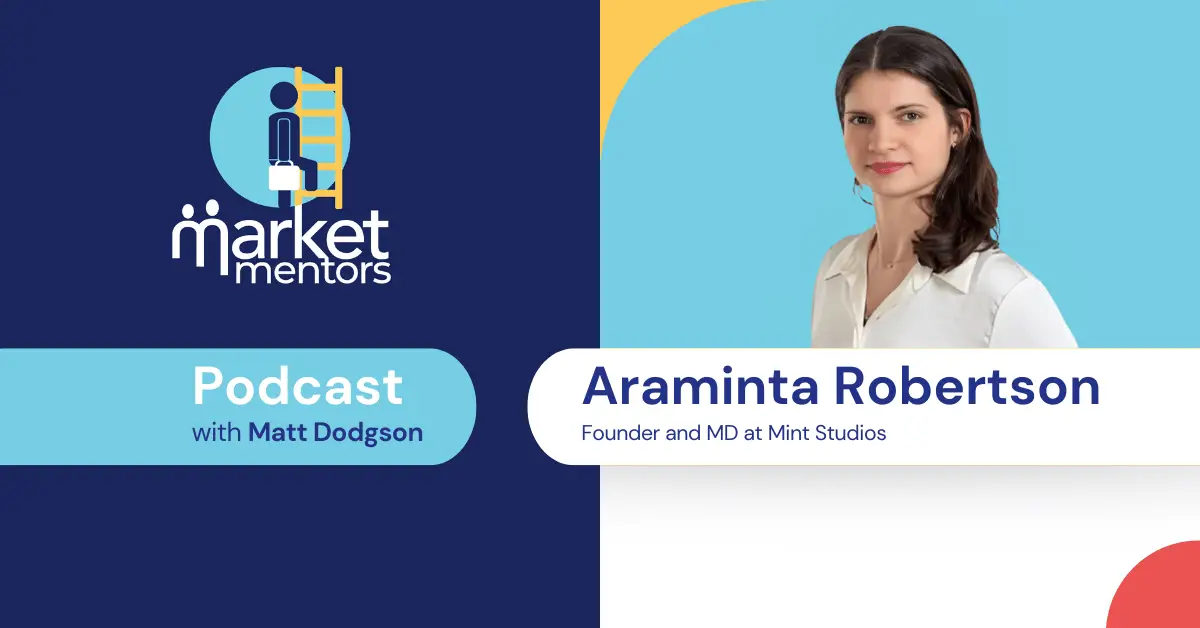
In this episode of the Market Mentors podcast, Matt Dodgson sits down with Araminta Robertson, founder and MD of content marketing agency Mint Studios, to explore the evolving landscape of B2B content marketing in 2025.
With marketing budgets under pressure and AI disrupting traditional content creation, many B2B marketers are questioning whether content marketing is still worth the investment. According to Araminta, the answer is a resounding yes.
“The best marketing strategy is always sharing expertise,” Araminta explains. “And the best way to share that expertise is still with content.”
She argues that content remains the fundamental vehicle for communicating expertise from subject matter experts to target audiences. The importance of content hasn’t changed, but how we create it and the focus on quality have.
When it comes to blogs specifically, Araminta believes they’re still worthwhile—as long as they’re reaching the intended audience. While SEO remains a viable distribution channel, social media has become more challenging due to platform algorithms that deprioritise posts with links.
“I think it all depends on the distribution channel,” Araminta notes. “People are still very much reading blog content.”
The key difference today is the need for a multi-channel distribution strategy rather than relying on a single approach. The traditional “create a blog then promote it via Facebook, X, Twitter, and LinkedIn” method is less effective as social platforms have reduced organic reach for shared content.
For B2B tech marketers looking to generate inbound leads through content, Araminta recommends starting with a tailored approach based on several factors:
“If you’re a content marketer…start with the bottom of the funnel. So that means creating a content strategy where you’re targeting people who are maybe more problem aware, more aware that they’re actively looking for a solution,” Araminta advises.
This results-orientated approach is especially valuable when working with leadership teams who want to see quick returns before increasing marketing budgets.
Rather than focusing on traditional demographic-based personas, Araminta recommends concentrating on pain points and motivations. She suggests engaging directly with sales teams to understand:
“I don’t think demographics are a very good way of understanding your customers,” Araminta explains. “The best thing is to sit down with the sales team and ask them questions.”
When investing in SEO-focused content, realistic timeframes for results depend on website maturity and target audience:
For situations where results will take longer than six months, Araminta recommends supplementing SEO with other marketing activities while building website authority through regular content and backlinks.
When tracking content marketing performance, Araminta focuses on:
While all these metrics provide valuable insights, conversions remain the north star measurement, with other metrics serving as indicators of progress.
When asked about creating content for “boring” B2B fintech solutions, Araminta challenges the premise: “What might be boring to me or you might not be boring to someone else.”
She emphasises that what matters most is whether the content helps your target customer. In many B2B contexts, particularly fintech, audiences often prefer straightforward information over flashy creatives.
“The industry that I’m in, you’re targeting really smart people that don’t have a lot of time and just want the information,” she notes. “I think it’s okay to keep it simple and just give them the information they need.”
According to Araminta, empathy—specifically the ability to put yourself in the reader’s shoes—is the most valuable skill for content marketers.
“If I were to summarise marketing in one sentence, it’s just understanding your target customer,” she explains. “Being obsessed with them.”
This deep understanding naturally drives marketers to research their audience thoroughly across multiple channels, from speaking with sales teams to following industry conversations on Reddit and LinkedIn. The result is content that resonates by addressing specific pain points that generic, AI-generated content cannot match.
While AI tools have transformed content creation, Araminta sees them as enhancements rather than replacements for human creativity. Her agency uses AI to improve content rather than generate it from scratch.
“We found that still to go from zero to one, AI is still not great at creating content that’s really high quality,” she notes. “The way we approach AI is more, how can we make it 10% better than what it currently is?”
For complex industries like fintech, human writers using AI as co-pilots produce significantly better results than AI alone. This approach preserves the original thought and expertise that distinguishes effective B2B content.
B2B content marketing remains a vital strategy for companies looking to showcase expertise and generate qualified leads. The keys to success in 2025 include understanding your audience deeply, focusing on pain points rather than demographics, and leveraging AI as an enhancement tool rather than a replacement for human creativity.
As Araminta puts it, “If everyone’s going to create AI content, then just doing that as well is just, what’s the point of marketing? The whole point is to stand out.”
Want to learn more? Araminta runs a Fintech marketing community with over 2,000 members, complete with a Slack group, events in London and New York, and the “Market Like a Fintech” podcast. It’s a free resource for marketers in the industry to exchange ideas and connect with peers.
Subscribe to our fortnightly newsletter to hear about our latest podcasts, blogs, career advice & jobs.